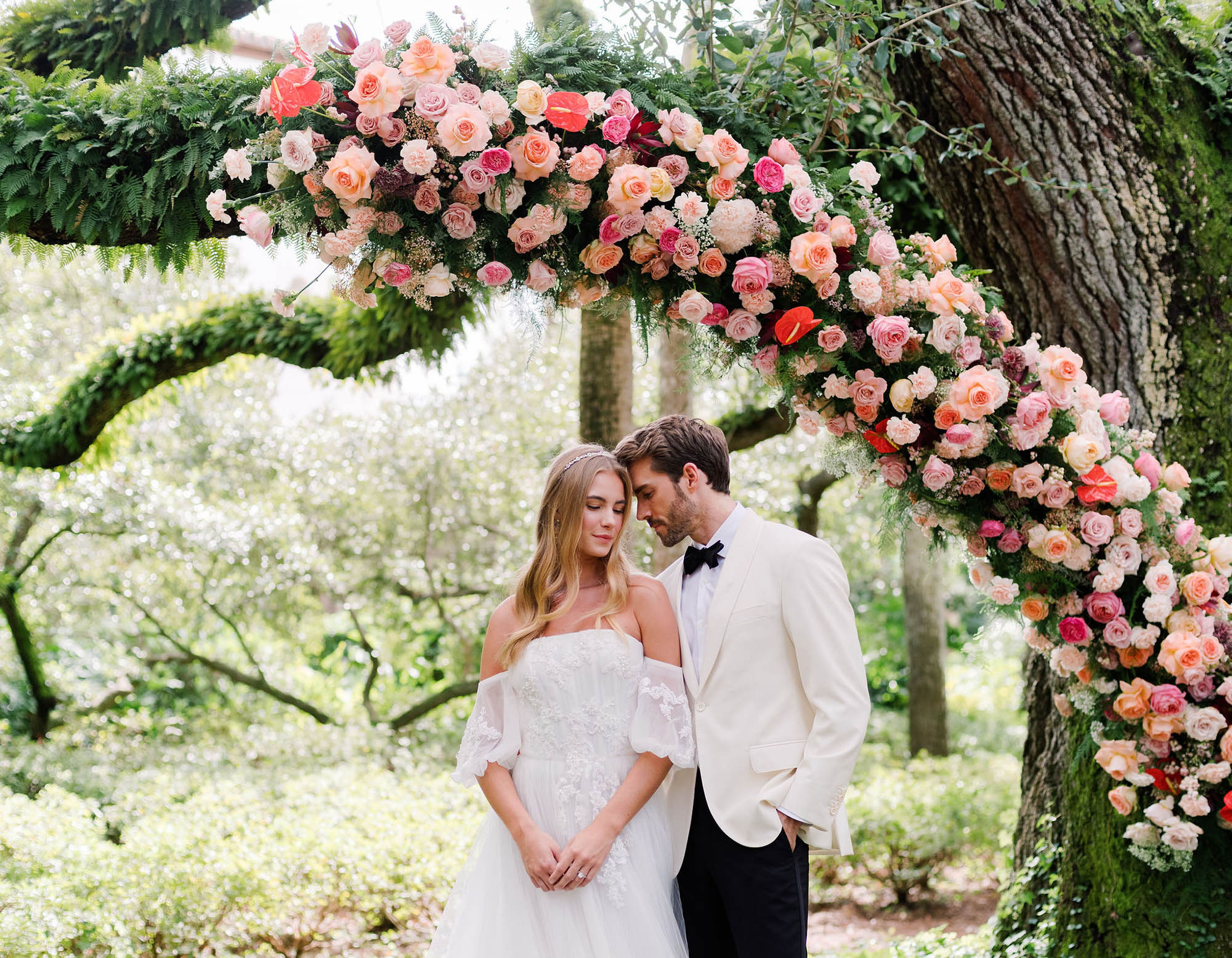In today’s post, I am going to be digging deep and sharing with you everything you need to know about the average cost of flowers for a wedding. This will help you calculate how much you can expect to spend in general, estimated terms. As you will see below, there are so many variables that go into each and every event, so your overall total average flower cost will likely vary from what I describe here. Nonetheless, this outline should help you get a good grasp on why flowers cost what they do, and also help you understand benchmarks for what typical floral line items realistically cost.
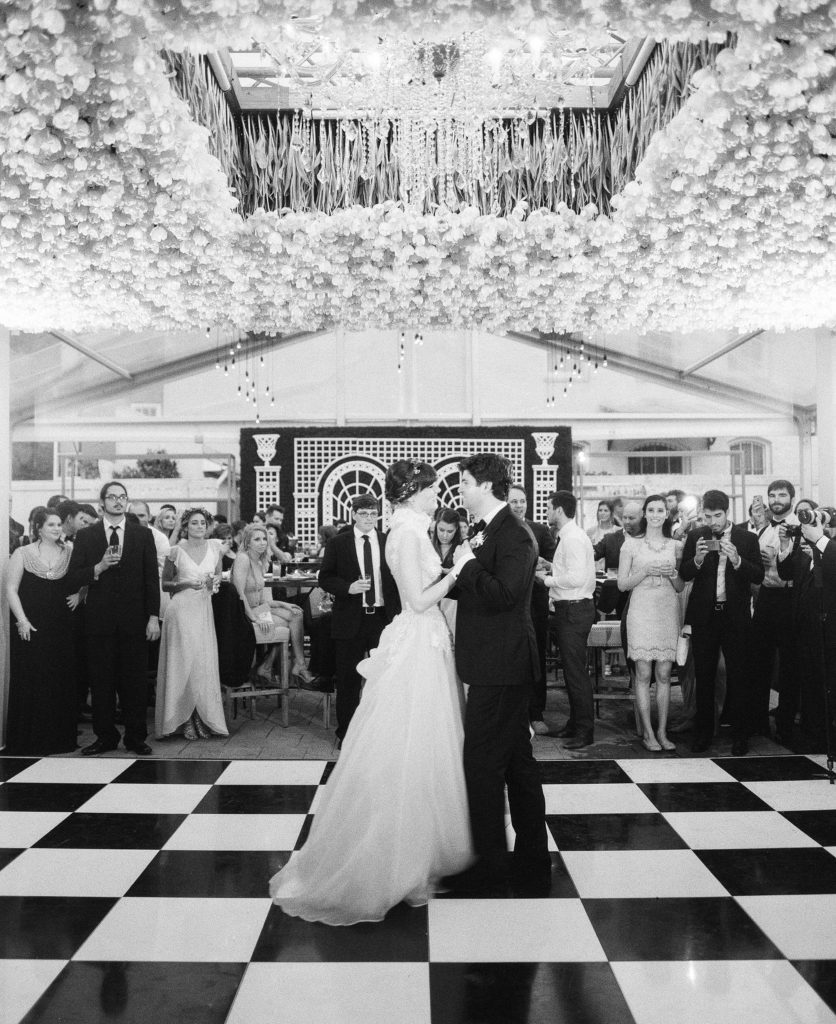
One of the aspects of wedding planning and event design that I absolutely love is the numbers. I get excited when I crunch numbers, and money matters are a HUGE part of the planning process that I have made my passion project, as an educational resource for both clients and my wedding planning colleagues alike.
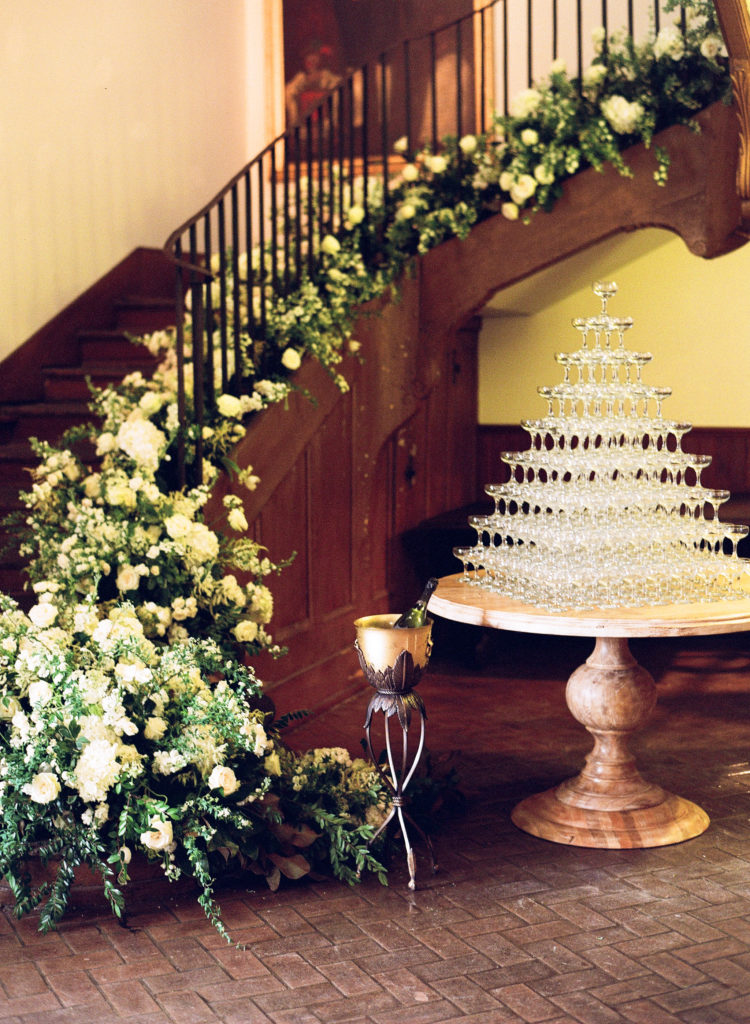
Today’s post is one part of a multi-post series I will be rolling out in the coming weeks discussing the costs of popular budget line items, so you can better understand what your investment in the big day could look like. You might have read this article or even this one about average costs of flowers for a wedding. I haven’t found an article with the information you’ll see in this post anywhere else on the internet, so I think you’ll find value in this and keep coming back for more!
What goes into the average cost of flowers for a wedding?
In short, there are a lot of back-end considerations professional florists account for that ultimately affect the cost of wedding day flowers. No, there is not a “wedding markup” at play here. This is the cost of doing business, and believe me, any floral business is an expensive business to run, perhaps more so than any other aspect of professional vendors you will encounter as you plan your big day.
DISCLAIMER
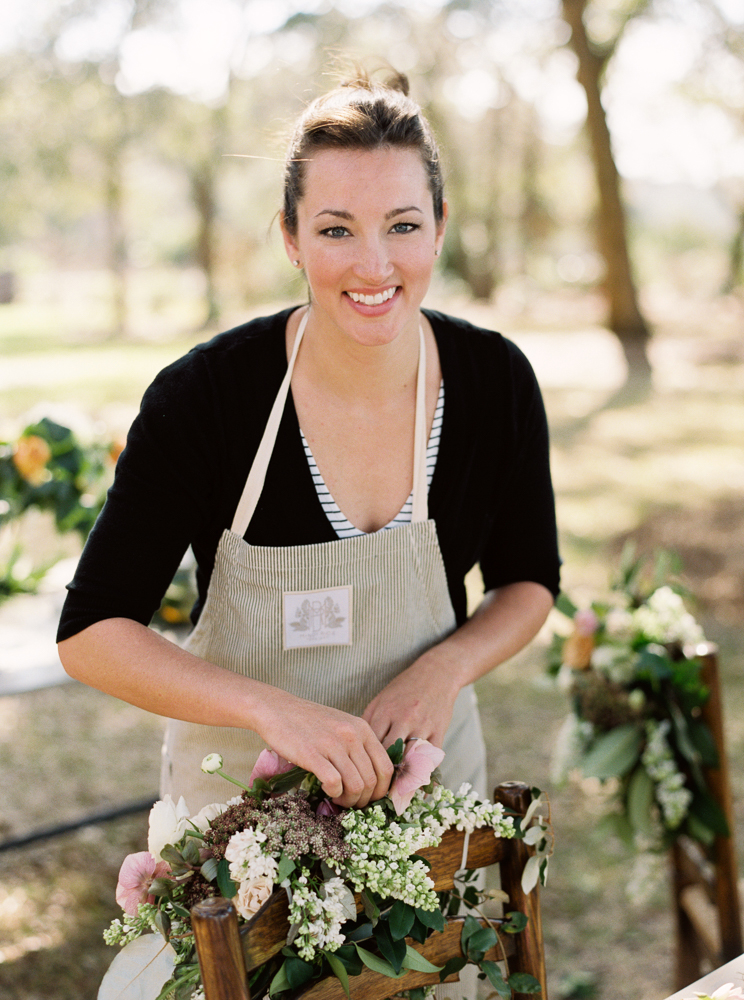
I am not a florist, nor do I have any desire to become one, for all of the reasons I outline below. I truly respect and adore the many talented florists I have come to know and learn from over the years. I continue to recruit the best florists in the business for our clients, I and work to understand what goes into every aspect of the industry for my clients’ benefit.
I have enough on my plate simply planning and designing an event day, and while I love playing around with a bouquet once in a while, I don’t have any interest in starting my own floral business while I am alive. I have so much respect for my flower heroes that I work with every day who make dreams come true for our clients! They do a much better job with flowers than I could do. I’ll stick to the big picture concepts!
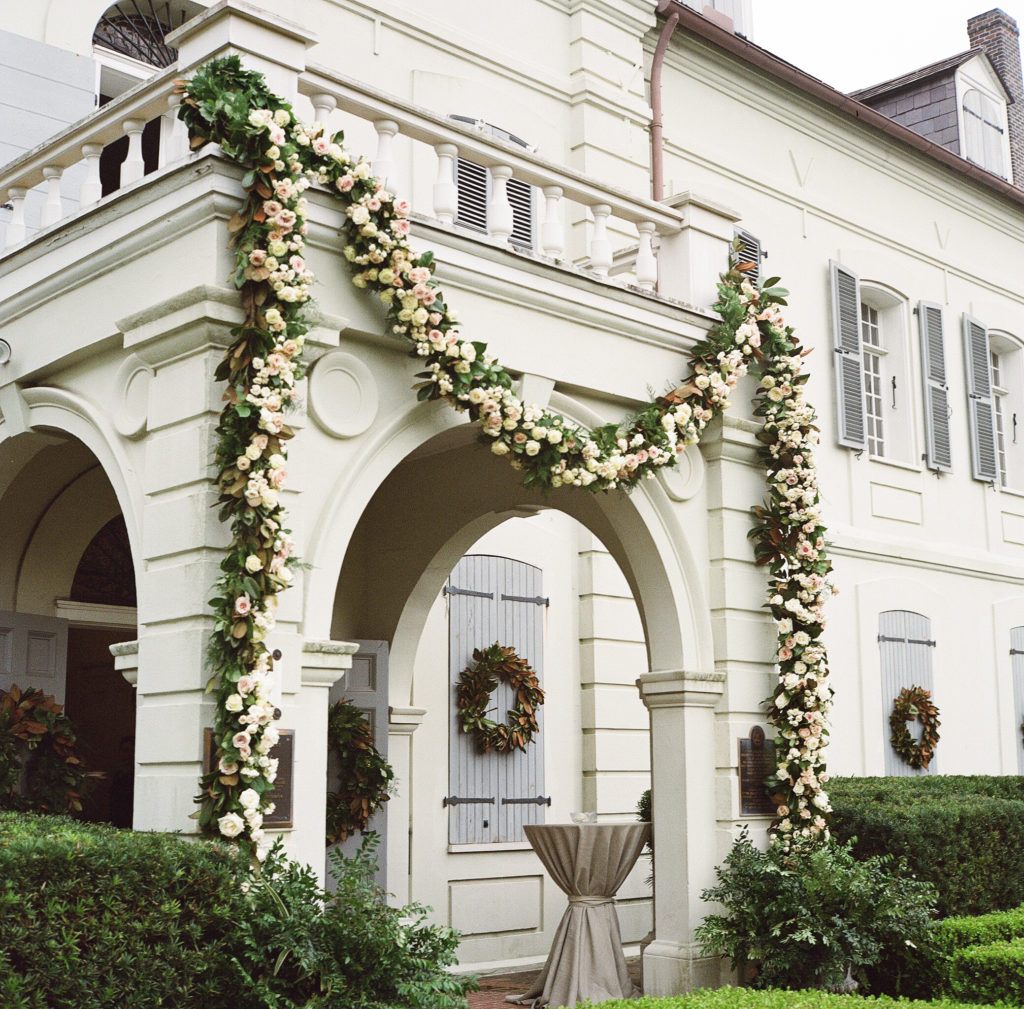
This information is a compilation of what I have learned from assisting florists on event days, attending floral design workshops and conferences, researching the overall costs of florist-related work, and from my own experience in events with over a decade in the business. I am continually educating myself and realize there is always so much to learn. This post is comprehensive, but still does not take into account lots of different variables and contingencies that go into each and every unique event.
Take it with a grain of salt. Your numbers may vary slightly one direction or the other. This information is intended as a guide to be used as a framework as you begin your florist research and lay a foundation for what to expect in an overall cost estimate for your particular floral investment.
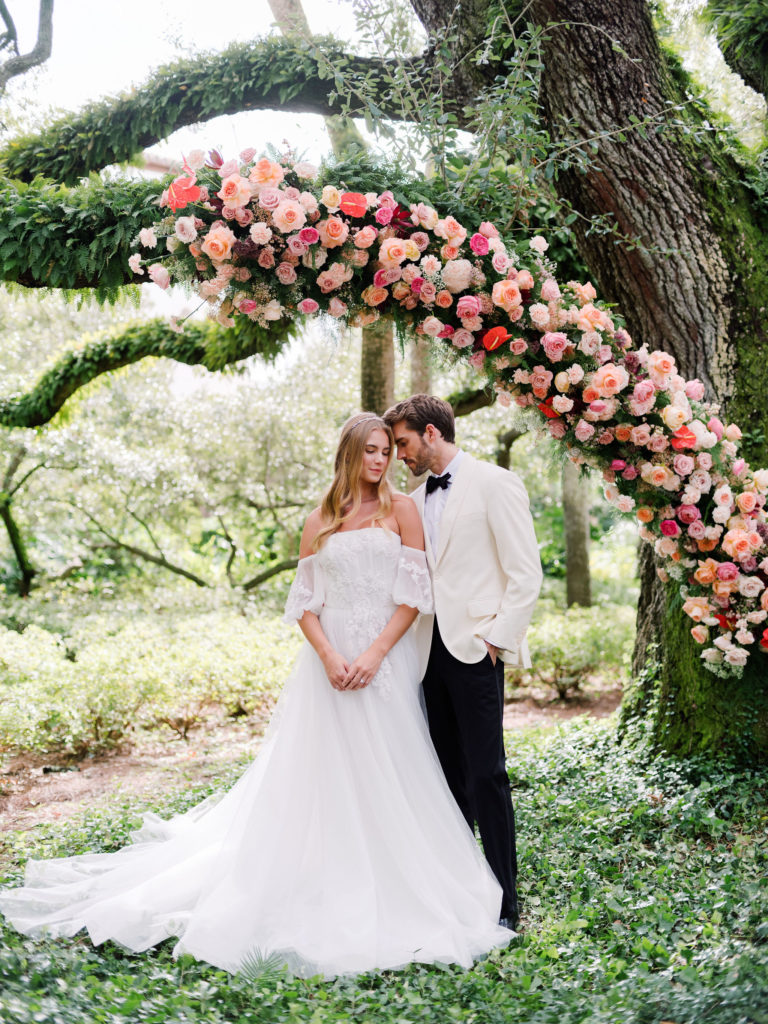
Some – but not all – of the variables that will affect your particular investment will depend upon the following:
- the types of flowers your florist and event design team select
- the labor intensity of those selections and your overall designs
- the time of year for your event and how it aligns with the growing and harvesting seasons for your selected flowers
- variables beyond anyone’s control (for example: a fire in a field in Ecuador that destroyed an entire crop of your particular roses, or an unexpected short supply/high demand for a flower variety that drives the cost up)
- the accessibility of a reliable wholesale provider in your florist’s market
- the overhead expenses of your florist
- the number of venues for your weekend of events
- And so. much. more.
To better understand the context of the average cost of flowers for a wedding, you have to know more about what costs your florist has to consider when writing a floral proposal for you. Before I get into the average costs of flowers for your wedding, keep in mind what goes into the back-end, overhead expenses your florist must accommodate in order to do their best work.
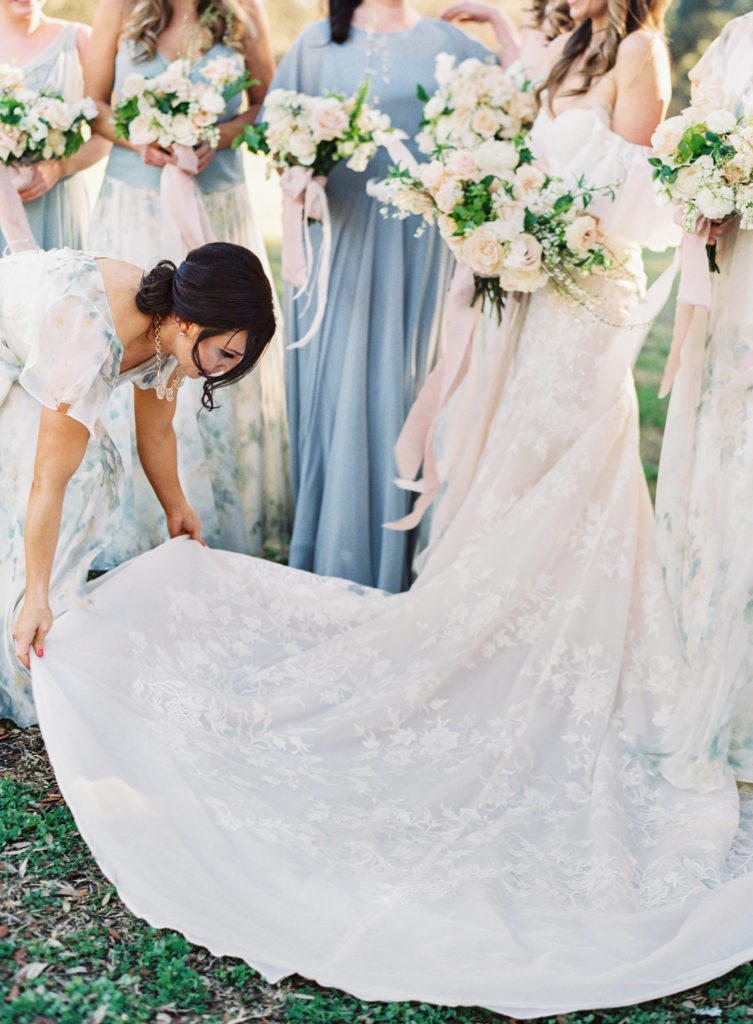
A typical list of expenses your florist has to pay for to bring your dream wedding day florals to life might look like this:
- The cost of design time your florist needs to create a plan for bringing the vision to life. This cost is one the florist has already paid for upfront over the course of many years, in education programs to learn about floral design, and the design tools your florist utilizes to create visual components of your floral proposal through sketches, renderings, and more. Don’t underestimate the price of the knowledge, research, and artistic license your florist has developed over the years to hone the skill set required for their art form.
- Paying for the supply chain for your flowers to get into your hands. This process involves growing, cutting, packaging, and selling the flowers to your florist. It begins with the grower on a farm somewhere in the world, who then cuts and sends an order placed by the wholesale provider on your florist’s behalf, who then ships the bulk order to your florist so that your florist can deliver at retail to you.
- The cost of the flowers themselves. Your florist will need to buy your particular flowers in bulk, in an amount over and above what is actually needed to account for loss, damage, or wrong variations. These incidentals can and do happen in a number of ways. Customs can stop flowers at the border for one reason or another, and if those florals do not get hydrated and stay cool, by the time customs processes a box of stems, the flowers are ruined.
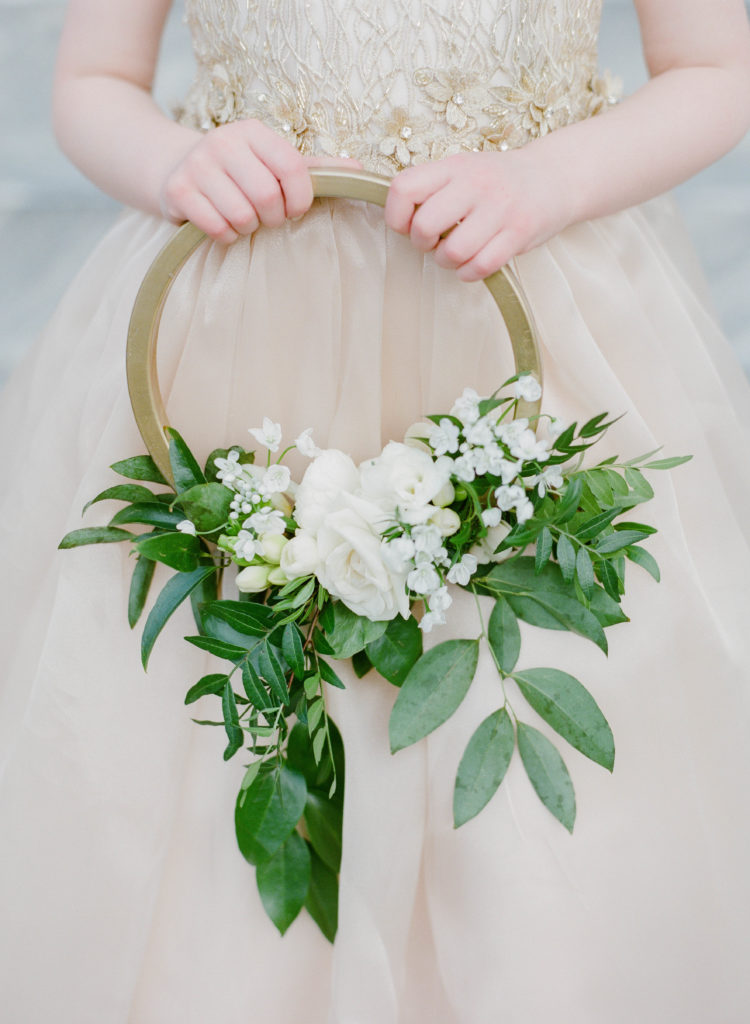
A note about how your florist receives flowers:
There is no way to predict how or when customs interference or damage will happen, but it does occur more often than you might think. Flowers can arrive in the hands of your florist damaged, either by a parasite, or quick decay, depending upon the unpredictable nature of growing a product and the number of things that can happen with genetics and a ton of other things.
It is very likely that your professional florist has a good relationship with a reliable wholesale flower supplier that can work to get a replacement, but this costs your florist additional time, money (rush fees) and stress (especially in getting the product to the florist in time to design for your event). The flowers might also arrive in the wrong color, in some cases requiring the florist to get creative with the product, or place a rush order for a replacement. Sometimes these situations can be remedied through the wholesaler, other times it is beyond everyone’s control and your florist must make do with the product as is.
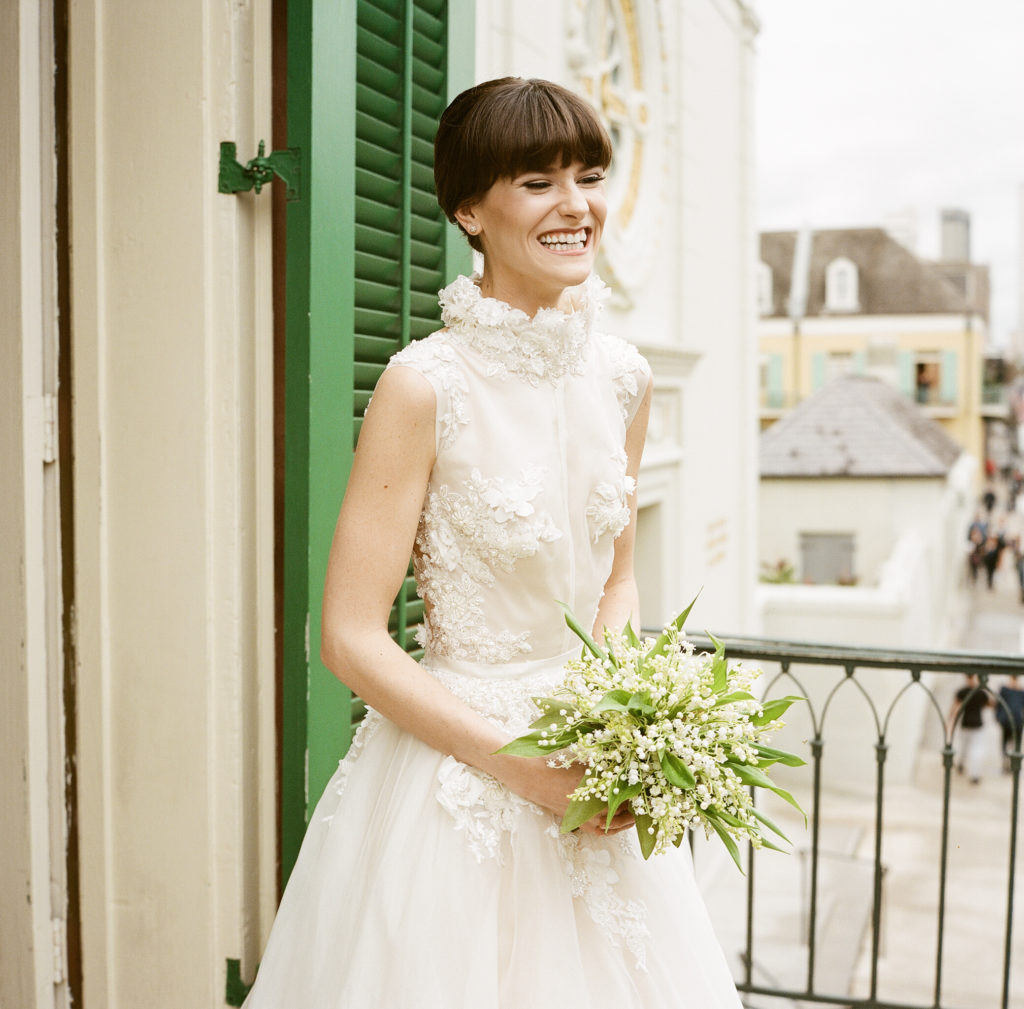
Ok now, back to our list of florist expenses:
- The cost of shipping from the wholesaler to your florist in the location of your event, almost always by air freight. This involves an early morning (as in a 2-3am wake up call) to get to the airport to pick up floral deliveries on Tuesday or Wednesday the week of your event, and then bringing the order to the warehouse or studio space where your florist will be working to begin processing the flowers.
- The cost of a reliable cooler and other forms of cold storage. Florals require a variety of controlled environments while being processed for design. Some need to warm up at room temperature, many need to stay cool. Your florist will need plenty of cooler storage space to contain all of the designs while they are being processed. These coolers are massive, require a lot of electricity, and take up quite a bit of square footage. Larger florist operations often require multiple coolers to manage the designs for all of their events in a given week.
- Rent for warehouse storage and design space. It takes lots of square footage necessary to receive, process, design, and store florals. Some florists might operate out of their home, others might rent space out of their wholesalers warehouse, others might rent or own their own studio to operate their floral business. These all need to be paid for by rent or mortgage in one capacity or another.
- Payroll for the labor force, including the number of designers needed during the week, the number of designers and installers needed the day of the event for setup, and the number of people needed for strike at the end of the event. Keep in mind there will be additional labor needed for your particular event if there is a “flip” of a space involved, because it is sometimes necessary to repurpose an area of your venue from ceremony to reception.
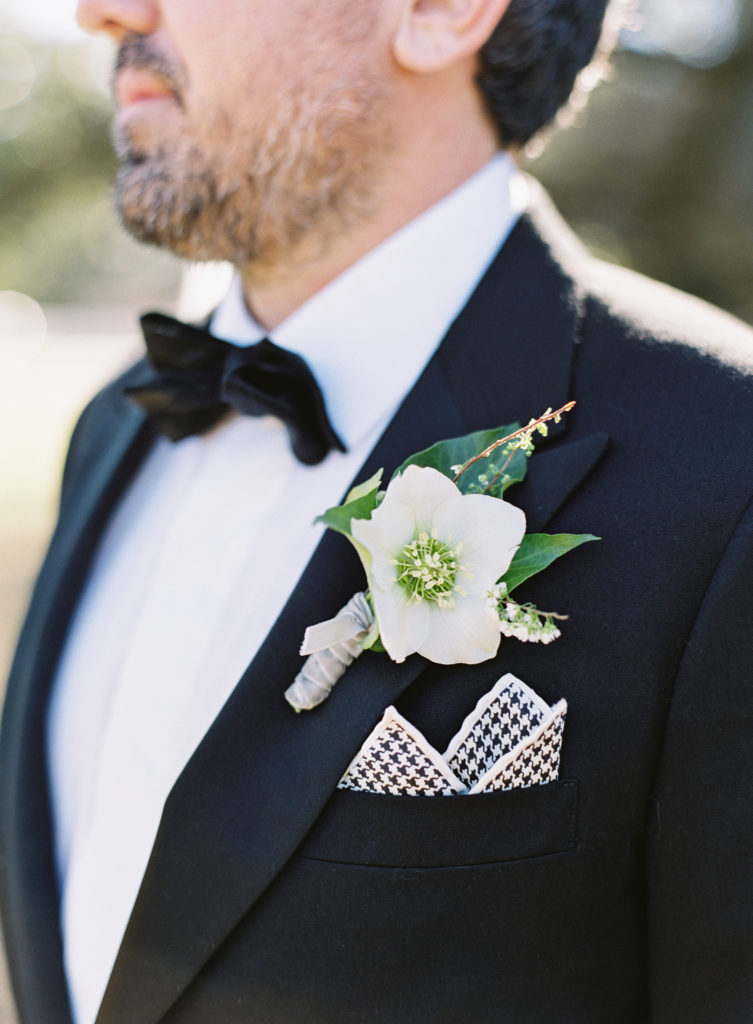
A note about labor costs:
The number of people necessary to execute repurposing of a space in a limited amount of time will be an additional cost. And the less time there is available to repurpose the space, then the more people your florist will need on site to execute. A HUGE factor in the average cost of flowers for a wedding, outside of the cost of the product itself, is going to involve labor.
Further, when repurposing arrangements, there is labor involved to transfer from point A to point B, requiring additional people on your florist’s team to remain on site during the ceremony who will then carry, load up, and deliver the arrangement to the next location. For example, expect to pay more in labor when you want to repurpose your ceremony altar pedestal arrangements to the guest book table at the reception, or if you want to reuse the rehearsal dinner flowers for cocktail hour at the wedding the next day.
Back to the list of florist expenses!
- The cost of processing the stems once they’ve been delivered. This involves trimming, hydrating, organizing, stripping, storing, and prepping all of the flowers in the particular manner they need to be cared for in order to be ready for the design stage. Clippers, gloves, buckets for water, hoses, pitchers, plumbing, and fertilizing treatments for blooms during this stage are all things your florist has to have on hand.
- The cost of owning and maintaining the vessels (vases, garden boxes, containers of all kinds) in which your flowers will be held. All of these containers will require storing, organizing, and cleaning in between events, as well as the containers needed to transport arrangements to the venue, bubble wrap when necessary for fragile vessels, racks for storage of the arrangements once they have been designed, and more.
- The cost of materials and mechanics used to create the flower arrangements. Flowers require a number of tools to create the glorious shapes and movement in the signature looks your floral designer is known for. Floral foam, chicken wire, boutonniere wire, zip ties, hot glue, 3M strips and hooks, floral tape, “frogs”, ribbon for bouquets, and plastic sheeting to protect surfaces while designing on site are a number of supplies your florist keeps in stock to use at each event.
- The cost of transporting the florals once they are prepped at the design studio. Getting the arrangements to and from each venue, in various degrees of completion, requires your florist to have ample moving equipment to manage the task, including a small yet mighty fleet of rental vans, trucks, rolling racks, and carts necessary to transfer the arrangements.
- The cost of candles. The candles themselves (votives, pillars, tapers, real or LED, etc), plus the vessels they go in (votive holders, hurricane cylinders, taper holders, candelabras, glass enclosures) plus necessary equipment like lighters, protective wrapping, and containers for transport and storage, etc. Not all candles can be reused from event to event, and in many cases florists buy new candles for each installation.
- The cost of installation, or putting the flower arrangements where they are supposed to go. Getting the arrangements on the tables to add finishing touches to the design, putting the stems into a larger installation, and any additional equipment (cherry pickers, scaffolding, ladders, platforms) that might need to be rented and transported to the venue in order for the florist to be able to properly install and secure the floral designs are added costs your florist has to pay for up front.
- The cost of removal and disposal of the flowers once the event is over. Your florist will be responsible for taking down all of the flower arrangements at the end of the event, and will need to properly dispose of the floral materials, any related packaging used throughout the installation process, and also take care of the rental equipment (vessels, fabrication materials) for inventory and storage.
- The cost of travel for the floral team, if your florist will be working in a remote location. These travel costs include per diems for each team member, plus food and beverage, hotel stays, rental cars and/or flights, and any additional room rental and utilities for the design space at the venue with access to running water, electricity and climate control capabilities.
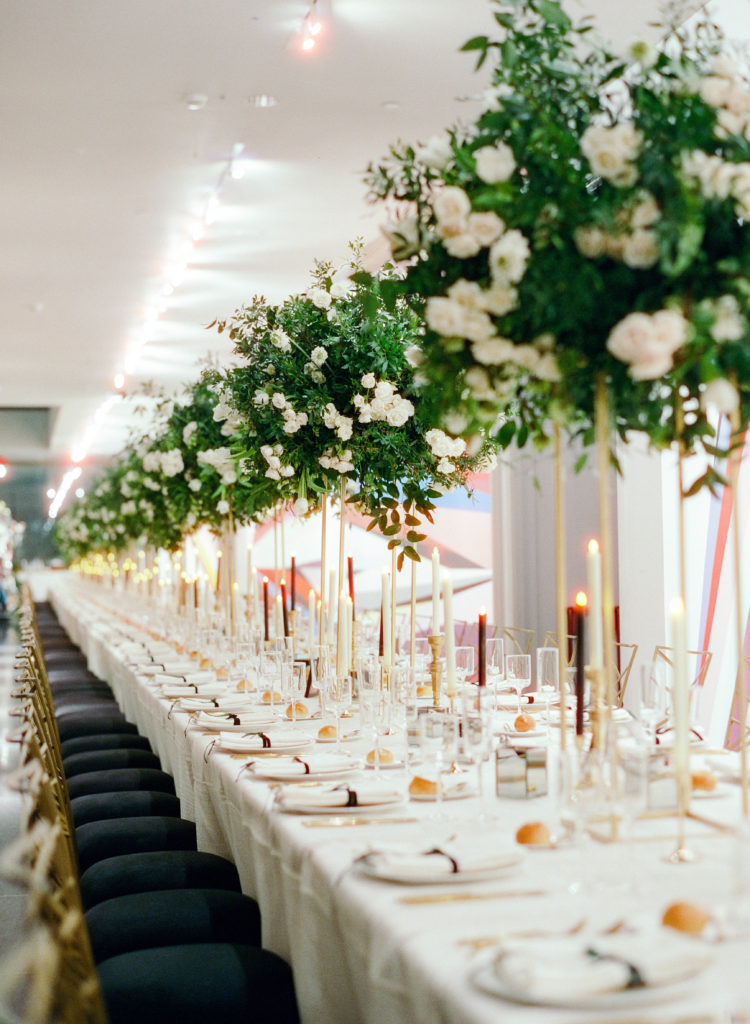
Whew! OK, now that we have gotten through the nuts and bolts of a florist’s overhead costs, let’s get to the good stuff. Now for the average cost of flowers for a wedding!
Keep in mind, some flower varieties cost more than others. Your florist will likely be working with several different varieties of blooms, and depending on what your main floral focal pieces are, the cost of certain stems will vary depending on a few factors.
Examples of flowers that tend to cost a bit more include:
Peonies (short growing season), orchids (difficult to grow), sweetpeas, lily of the valley (delicate, finicky blooms), any blooms in short supply and high demand (depending on growing season/time of year)
Examples of flowers that tend to have a moderate cost under relatively normal conditions:
Roses, hydrangea, tulips (more easily accessible, can be grown in large quantities, a bit more sturdy overall, readily available)
Examples of flowers that are generally inexpensive:
Mums, carnations, baby’s breath, (low maintenance, super accessible, grow anywhere)
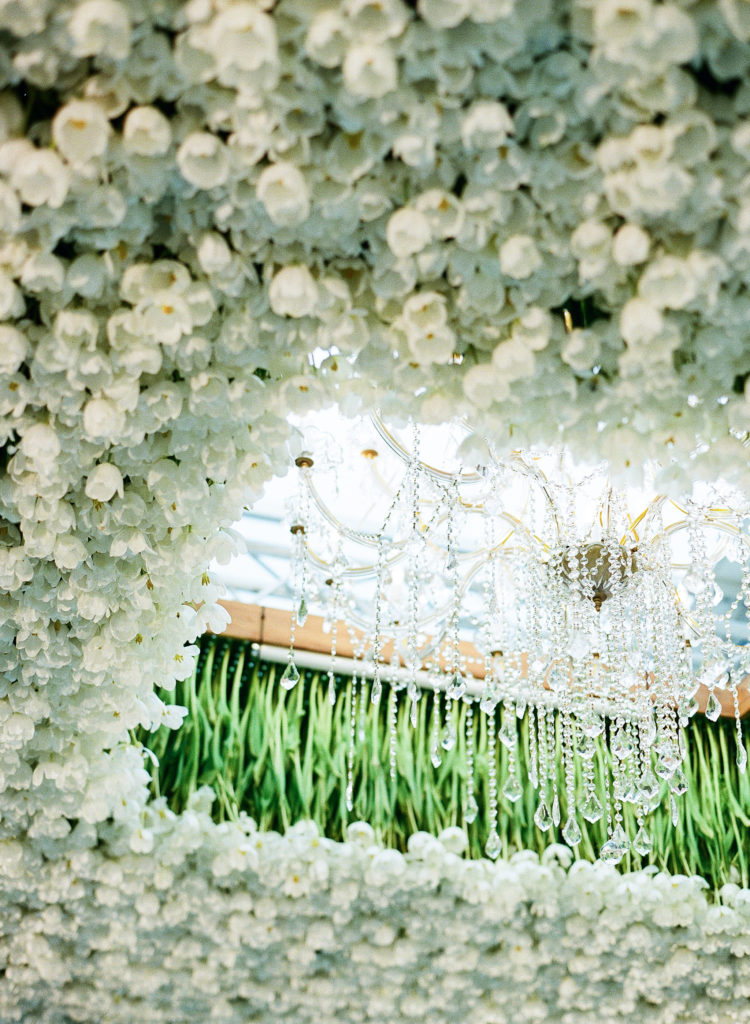
Average cost of flowers for a wedding – line items
These are ranges that reflect average cost of flowers for a wedding in a mid-level market. In more rural areas, these costs might be much lower; in urban areas, these costs might actually be much higher. Keep in mind these are averages and there is a lot of variability that can affect your actual price point.
Personal Flowers
Add up the number of people you have in your family and wedding party that needs flowers of some kind, and calculate your estimated personal flower cost based on the below:
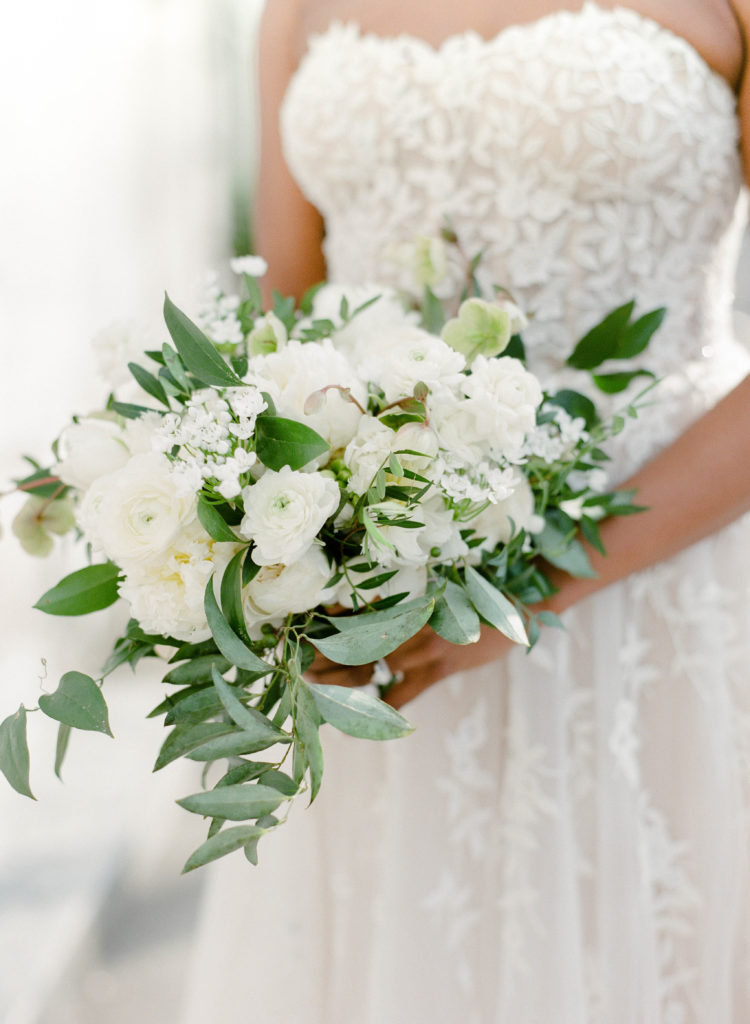
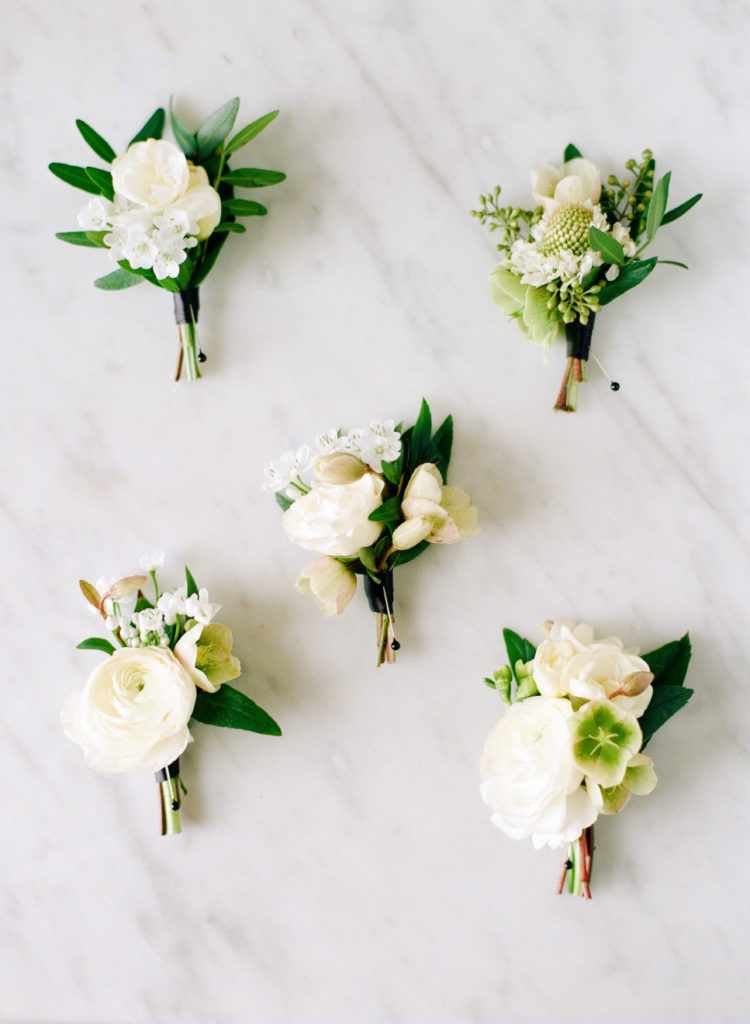
- Bridal bouquet $350-$500
- Bridesmaids bouquets $150-$300 per bouquet
- Boutonnieres $20-$30 (labor intensive) per boutonniere
- Corsages $30-$50 (labor intensive)
- Nosegays (small bouquets for mothers) $50-$75
- Hair wreaths ~$100
- Individual stems for hair $35-$75
- Flower girl flowers ~$100
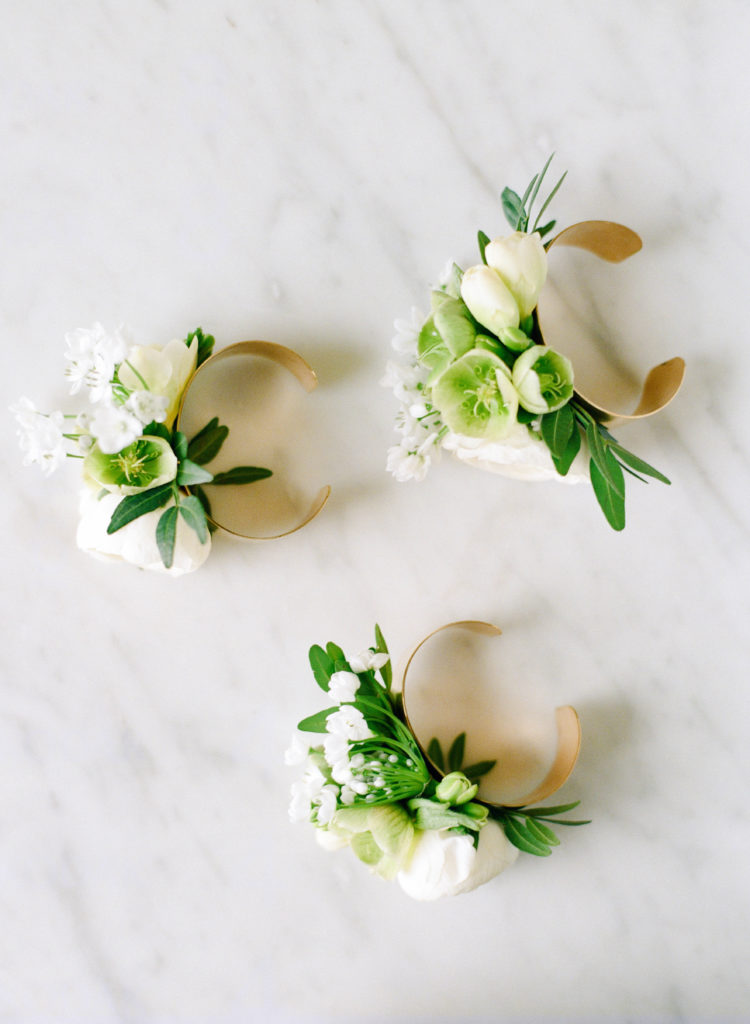
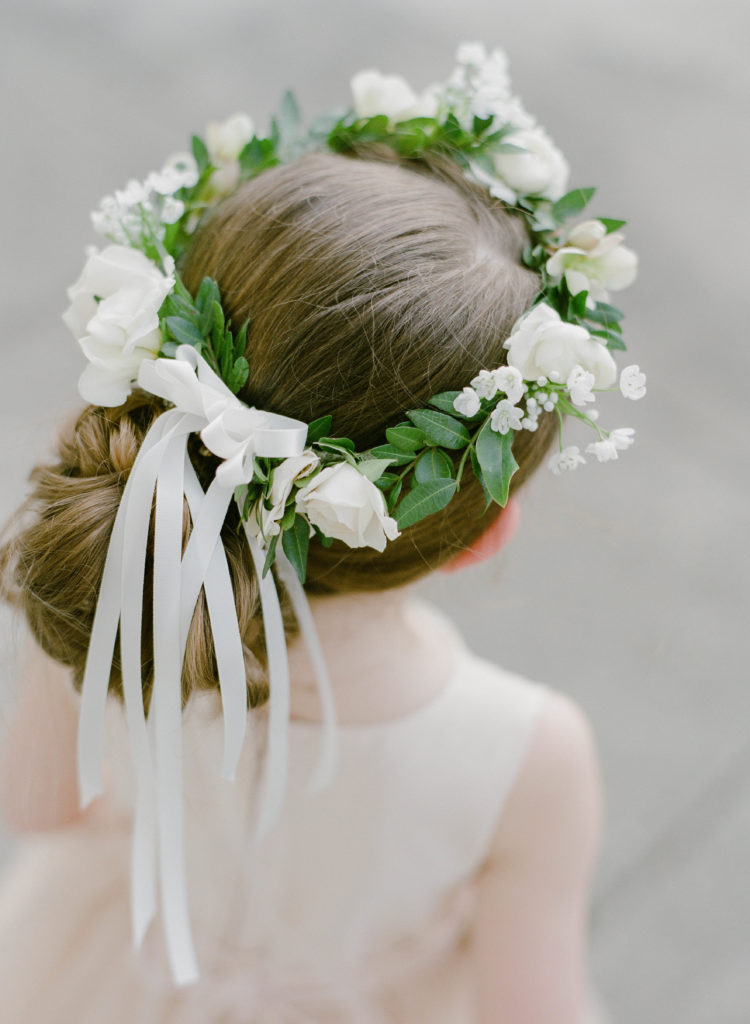
Ceremony flowers
There are countless various possibilities of flowers you might use for your ceremony space.
Altar arrangements
- chuppah build-out: anywhere from $4,000-$15,000+
- archway: $2500-$6000+
- altar arrangement at a place of worship: $600-$1200 each
- pedestal arrangements: $750-$1500 each
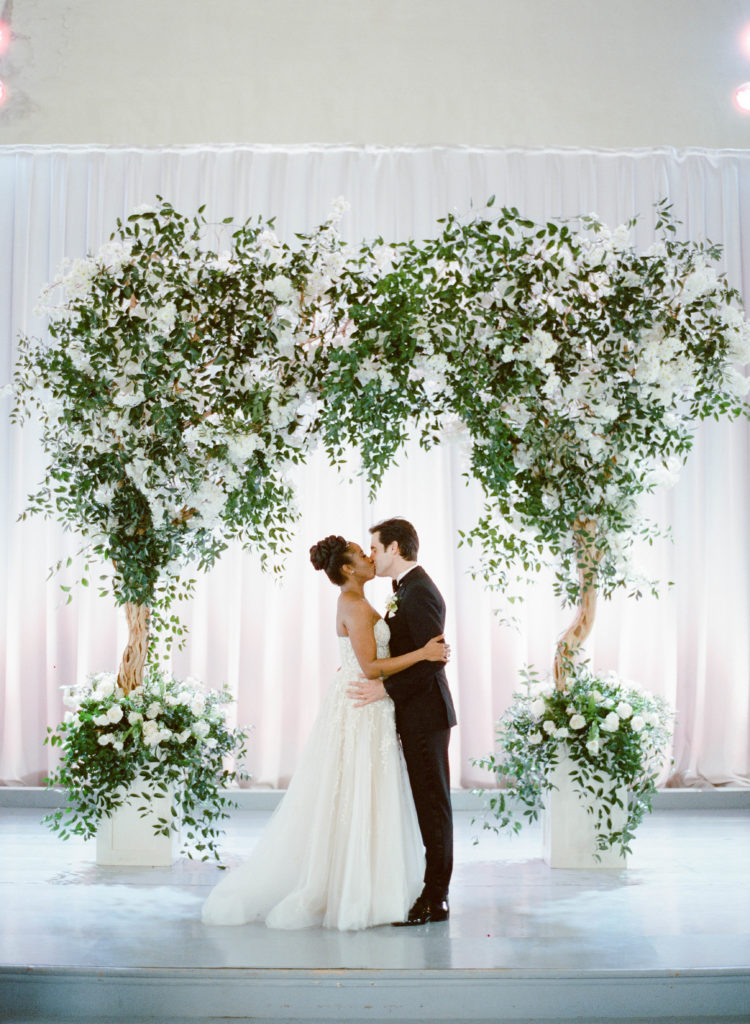
Aisle arrangements
- Boxes/runners down the aisle: $100-$300 per linear foot, x2 (both sides of the aisle)
- chair ornamentation marking each row: $50-$150 per row
- behind the last row: $100-$300 per linear foot
- pedestal arrangements at the entry of aisle/back of aisle: $750-$1500 each
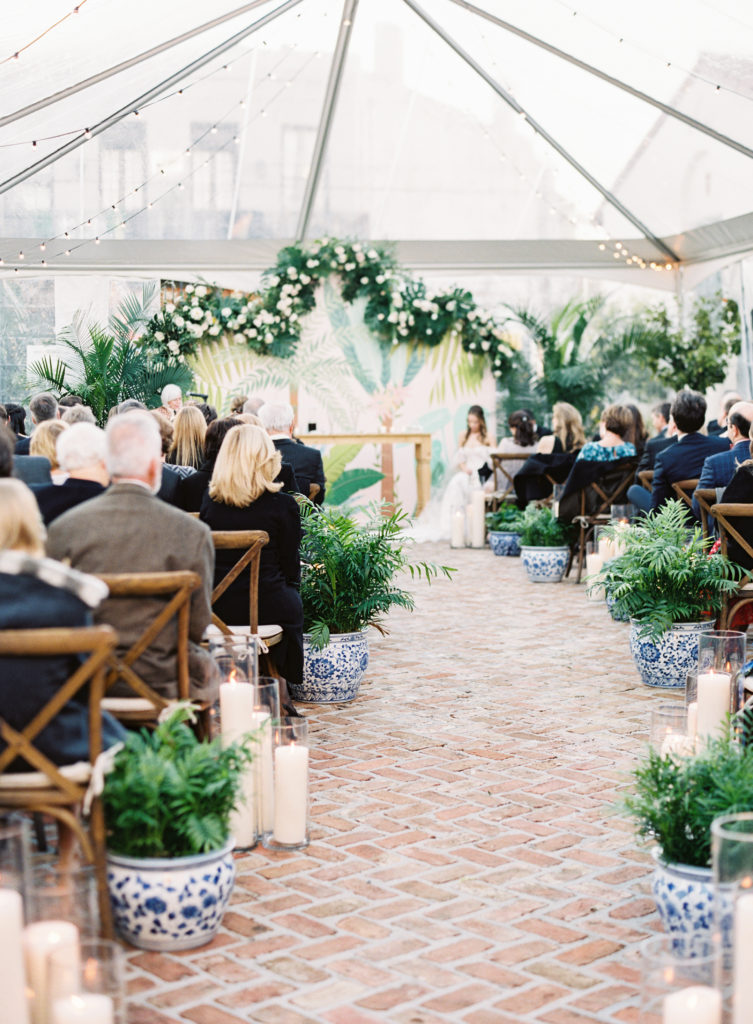
Venue entrance arrangement ideas
- wreaths on gate: $250-$750
- floral garlands: $250-$500 per linear foot
- greenery garlands: $100-$300 per linear foot
- florals at informational signage: $500-$800+ each
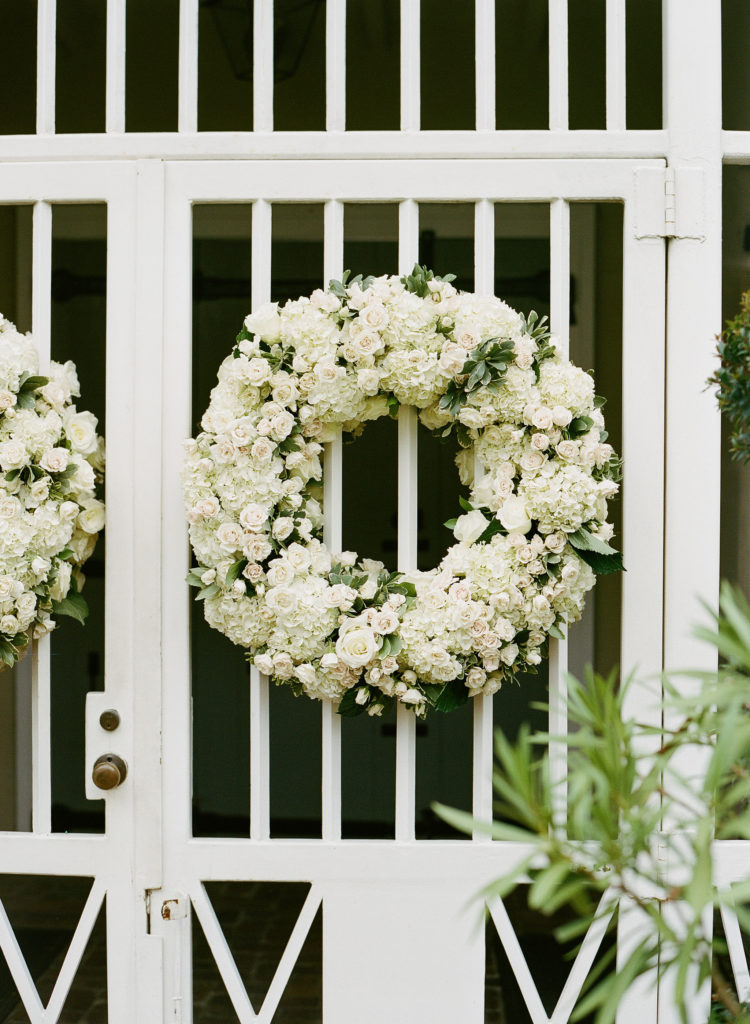
Reception flowers
Cocktail hour
Cocktail tables – smaller round tables than those used for dinner
- low profile arrangements, smaller in footprint: $150-$450+
Highboy tables – to gather around for conversation
- bud vases, julep cups, low profile arrangements: $50-$150
Lounge seating – coffee tables, end tables
- $150-$450
Bar decor
- garland: $150-$300 per linear foot
- vase arrangement: $500-$750+
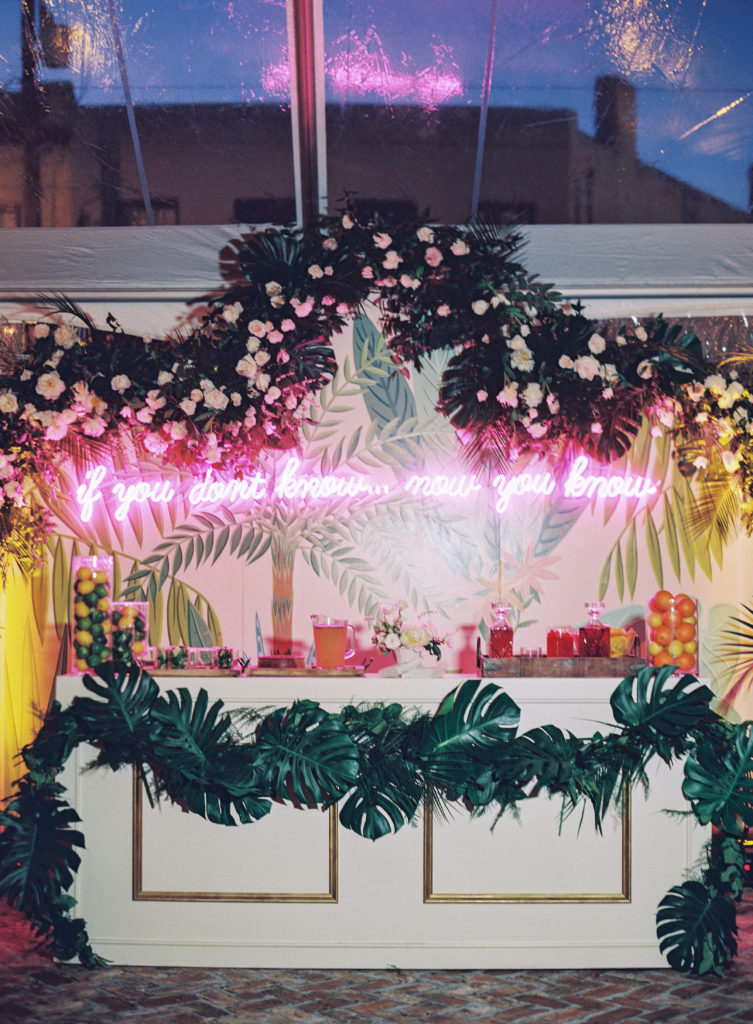
Escort card display – florals only (not including any custom build infrastructure, or required linens, et. al.)
- custom fabricated display: $1500-$4500+
- table top display: $750-$1200+
Guest book table – florals only (not including any custom build infrastructure, or required linens, et. al.)
- table top display: $750-$1200+
Reception Dinner
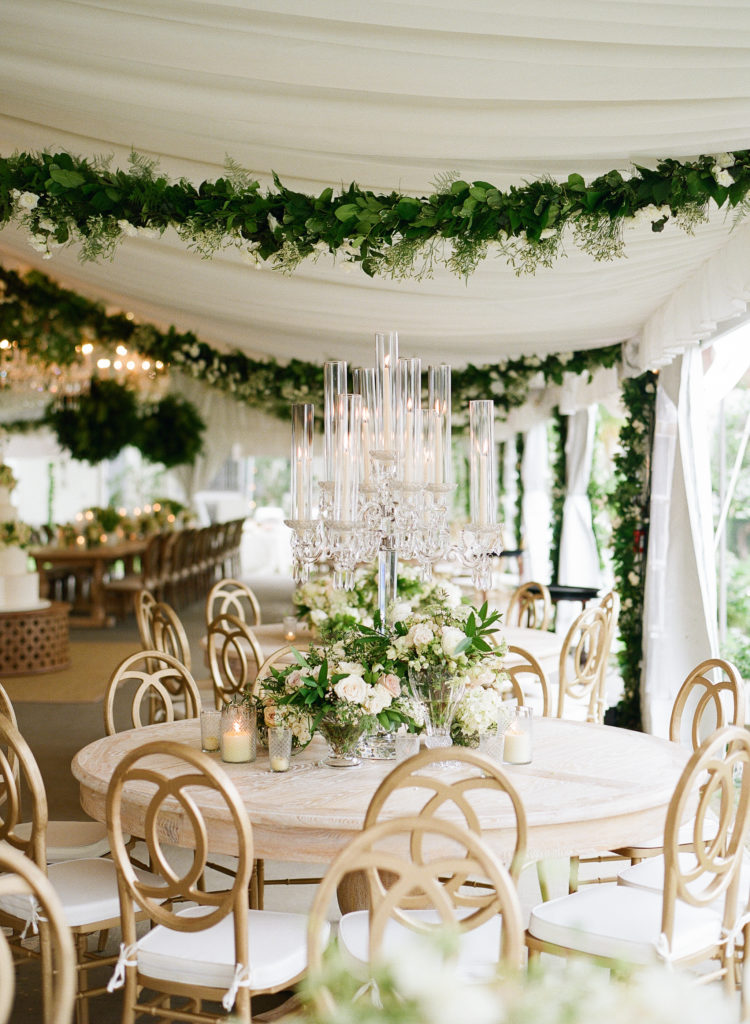
Round and/or rectangle tables
- tall floral arrangements: $750-$1800+ each
- mid-level floral arrangements: $400-$800+ each
- low lush floral arrangements: $300-$500+ each
Long consecutive tables
- tall floral “bridge” arrangement: $2500-$5000+ per every 6 foot table
- floral garlands: $250-$500+ per linear foot
- greenery garlands: $100-$300+ per linear foot
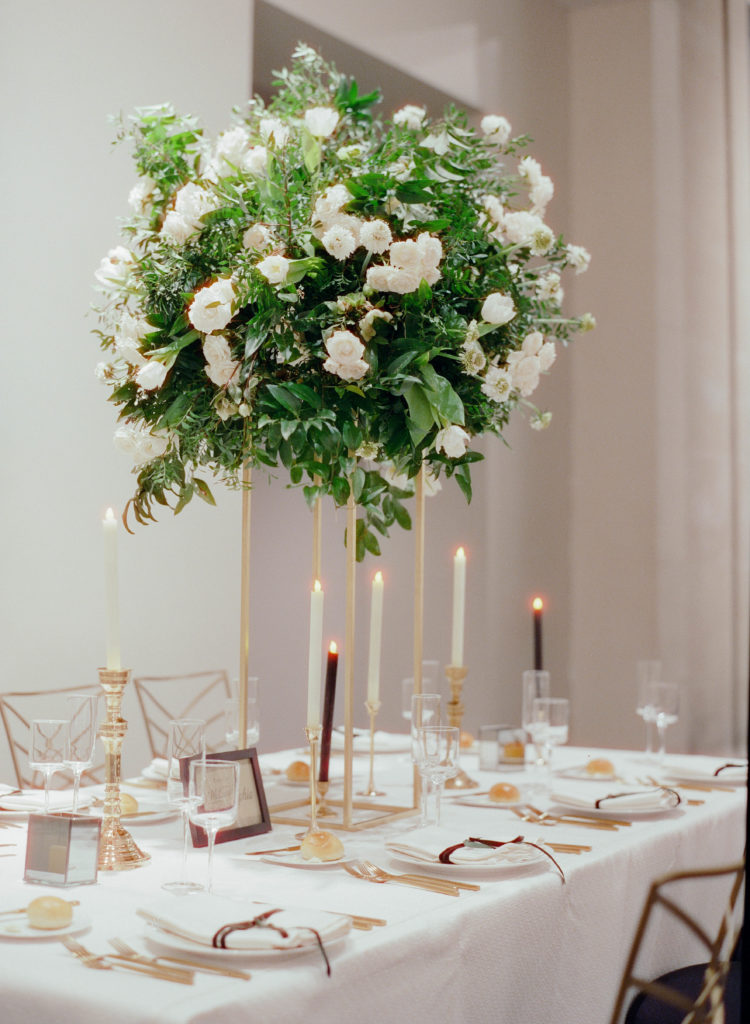
Dancing
Stage surround florals only (not including any physical boxes or support system for the florals, which may be additional and come from a rental company or production company)
- $3000-$6000+
Band backdrop:
- floral decor: $3000-$8000+
- greenery decor: $1500-$3500+
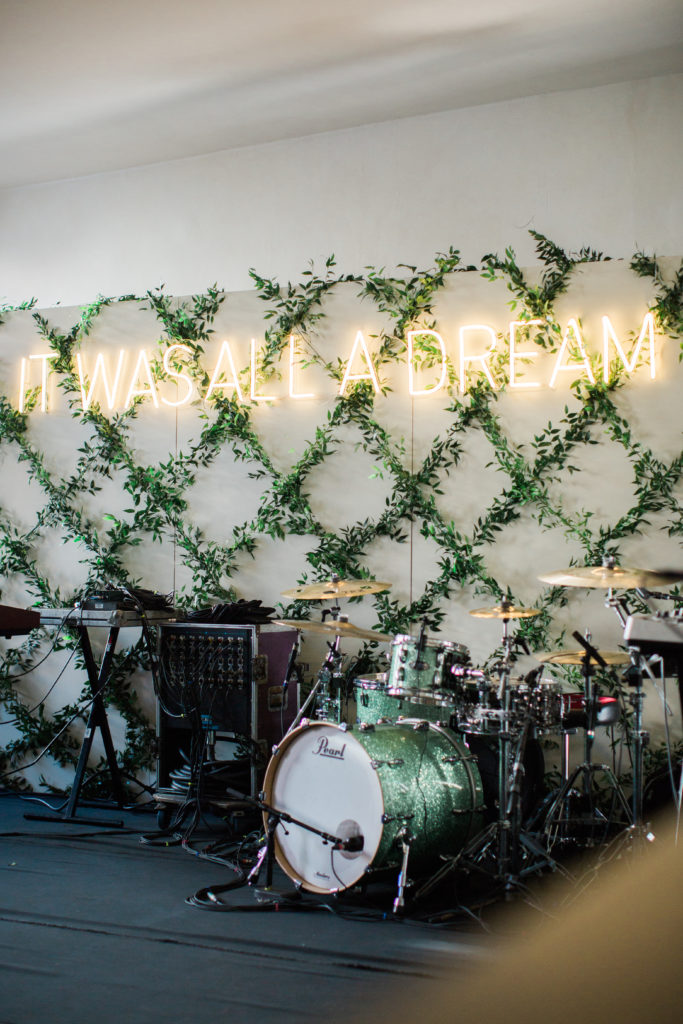
Chandelier decor – floral decor only (so, not including the chandeliers themselves, which I am factoring in as being provided by another company or existing in-house at the venue)
- floral decor: $500-$800+
- greenery decor: $250-$650+
Hanging floral focal installation
- starting at around $4000 and ranging upwards of $10,000++
Floral wall
- starting at around $7500 and running upwards of $12,000++
Cake floral decor
- $150-$500+
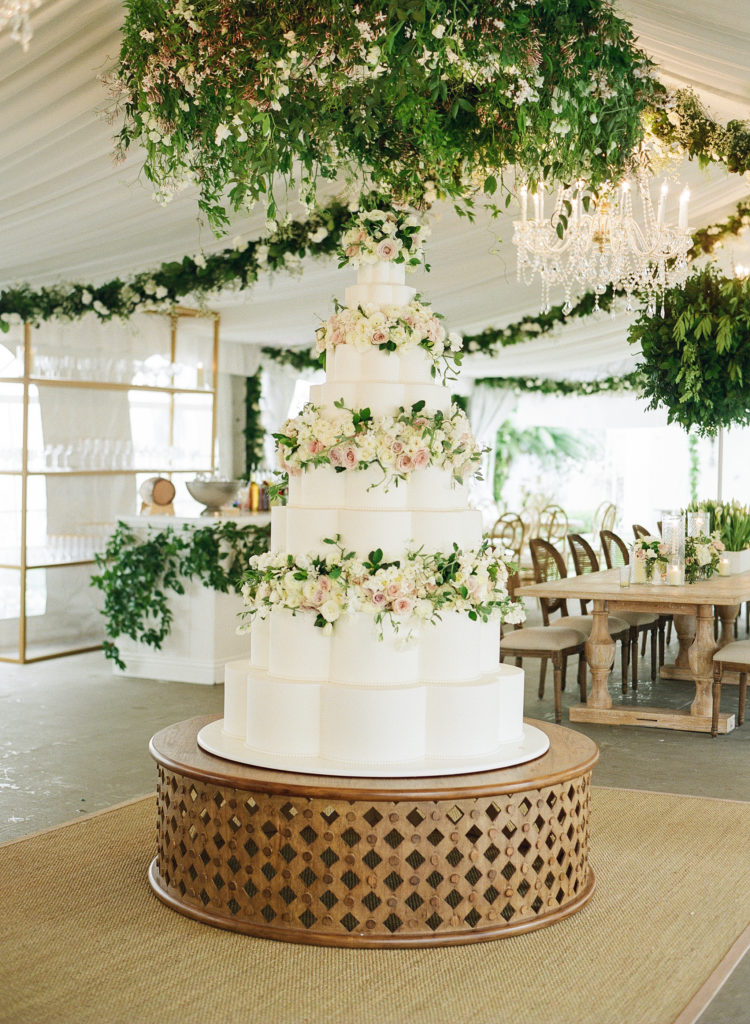
Tent floral decor accessories
- Pole decor, vines and other organic elements used to camouflage or soften hard lines of a tent interior: $2500-$6000++
Other costs to consider:
Design Fee – this varies among florists, but in essence this fee compensates the florist for the time spent designing your event, and in collaborating with your planner and event design team to bring the specifics of the event together to support the cohesive vision of the big day.
Taxes – state and local sales tax will apply to the cost of goods on your order.
Labor charge – typically a percentage of the overall cost of the proposal. This percentage varies among florists depending on their level of overhead costs and the labor specifically required for your event.
Cost of a mockup or prototype of the design – this will be in addition to the above costs for the actual event itself. Also keep in mind that because of the nature of the flower supply chain, your florist will have to order more product than needed to account for the loss and damage possibility. Plus, wholesalers supply product in bulk, so even if your florist only needs a few stems of a certain variety, the wholesaler will charge your florist the cost of the full bunch, and that cost will be passed on in the cost of the mockup. It is not at all unusual for the cost of the mockup to be more than the individual items you might pay for on the actual event day.
Travel fees – typically a flat fee for all travel-related costs for the events, including per diem, hotel rooms, and transportation.
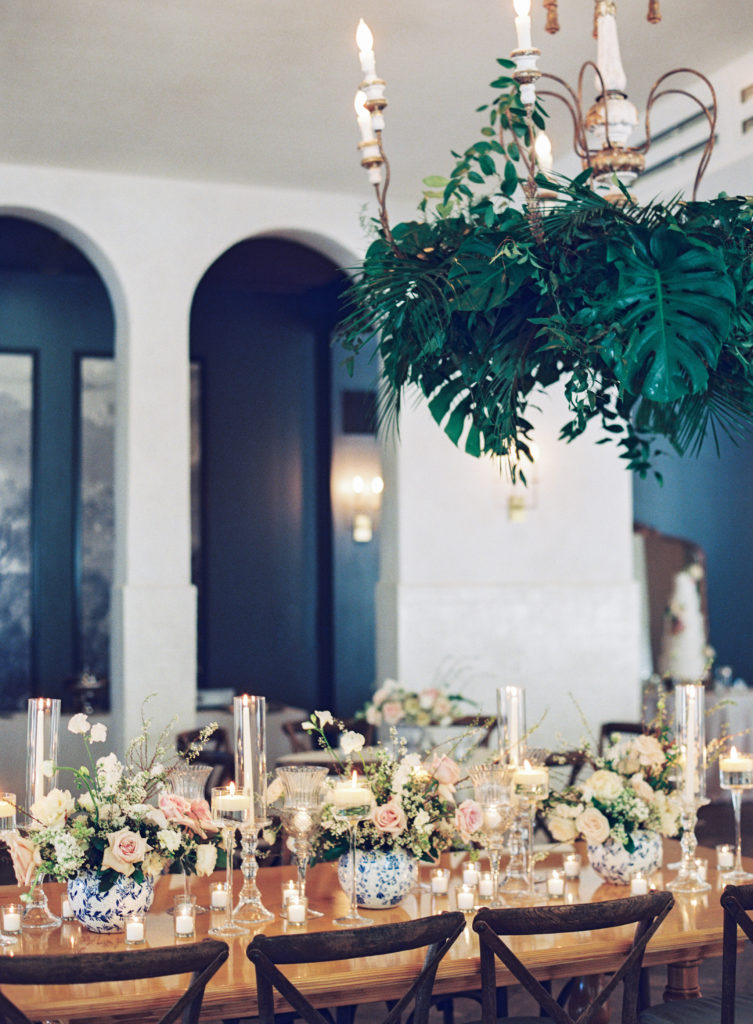
I hope this has helped provide you with valuable information to get a realistic understanding of what to expect for the average cost of flowers for your wedding. As I mentioned, these numbers are intended as guidelines to help you understand the context of what to expect to see in a floral proposal, but your exact numbers will likely vary depending on a number of factors. Keep in mind this is my estimate for the average cost of flowers for a wedding – I cannot possibly report on all the variations you might actually see in your florist proposal, so take this with a grain of salt!
Let us know in the comments what else you’d like to see for a financial breakdown on your wedding day costs!
YOU MIGHT ALSO LIKE:
Now THIS is how you host a private home wedding!
10 secrets your wedding planner doesn’t want you to know
This is what happens when a bride asks her guests to wear all white
9 things you should absolutely do first after getting engaged
Pinterest wedding planning tips for the most amazing wedding

